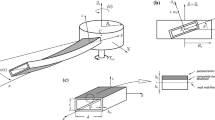Abstract
This paper addresses the problem of the modeling and vibration control of tapered rotating blade modeled as thin-walled beams and incorporating damping capabilities. The blade model incorporates non-classical features such as anisotropy, transverse shear, secondary warping and includes the centrifugal and Coriolis force fields. For the rotating blade system, a thorough validation and assessment of a number of non-classical features including the taper characteristics is accomplished. The damping capabilities are provided by a system of piezoactuators bonded or embedded into the structure and spread over the entire span of the beam. Based on the converse piezoelectric effect, the piezoactuators produce a localized strain field in response to a voltage and consequently, a change of the dynamic response characteristics is induced. A velocity feedback control law relating the piezoelectrically induced transversal bending moment at the beam tip with the appropriately selected kinematical response quantity is used and the beneficial effects upon the closed-loop dynamic characteristics of the blade are highlighted.
Similar content being viewed by others
References
Berlincourt, D. A., Curran, D. R. and Jaffe, H., 1964, “Piezoelectric and Piezomagnetic Material and Their Function in Transducers,” Physical Acoustics-Principles and Methods, (Eds. W. P. Mason), Vol. 1, Part A, Academic Press, New York and London, pp. 169–270.
Hodges, D.H., 1981, “An approximate Formula for the Fundamental Frequency of a Uniform Rotating Beam Clamped Off the Axis of Rotation,” Journal of Sound and Vibration, Vol. 77, No. 11. pp. 11–18.
Librescu, L., Song, O. and Rogers, C. A., 1993, “Adaptive Vibrational Behavior of Cantilevered Structures Modeled as Composite Thin-Walled Beams,” International Journal of Engineering Science, Vol. 31, No. 5, pp. 775–792.
Librescu, L., Meirovitch, L. and Song, O., 1994, “Vibration and Static Aeroelastic Instability of Nonuniform Thin-Walled Beam Composite Wings,” AIAA/ASME/ASCE/AHS/ASC 35th Structures, Structural Dynamics, and Materials Conference, Paper AIAA-94-1491, Hilton Head, SC.
Du. H., Lim, M. and Liew, K. M., 1994, “A Power Series Solution for Vibration of a Rotating Timoshenko Beam,” Journal of Sound and Vibration, Vol. 175, No. 4, pp. 505–523.
Park, J. and Yoo, H., 1996, “Bending Vibration of a Pretwisted Rotating Cantilever Beam,”KSME Journal, Vol. 20, No. 7, pp. 2174–2181.
Librescu. L., Meirovitch, L. and Na, S. S., 1997, “Control of Cantilevers Vibration Via Structural Tailoring and Adaptive Materials,”AIAA Journal, Vol. 35, No. 8, pp. 1309–1315.
Song, O. and Librescu, L., 1997, “Structural Modeling and Free Vibration Analysis of Rotating Composite Thin-Walled Beams,”Journal of the American Helicopter Society, Vol. 42, No, 42 pp. 358–369.
Na, S. S. and Librescu, L., 1999, “Dynamic Behavior of Aircraft Wings Modeled as Doubly- Tapered Composite Thin-Walled Beams,” P.V.P Vol. 398, Recent Advances in Solids and Structures, Ed. Y. W. Kwon, H. H. Chung, ASME 1999, pp. 59–68.
Na. S. S. and Librescu, L., 2000a. “Modeling and Vibration Feedback Control of Rotating Tapered Beams Incorporating Adaptive Capabilities,” PVP-Vol. 415, Recent Advances in Solids and Structures, ASME 2000, pp. 35–43.
Na, S. S. and Librescu, L., 2000b, “Optimal Vibration Control of Thin-Walled Anisotropic Cantilevers Exposed to Blast Loadings,” J. of Guidance, Control and Dynamics, Vol. 23, No. 3, pp. 491–500.
Kim, S. and Yoo, H., 2002, “Vibration Analysis of a Rotating Cantilever Plates,”KSME International Journal, Vol. 16, No. 3, pp. 320- 326.
Meirovitch, L., Principles and Techniques of Vibrations, Prentice-Hall, Englewood Cliffs, NJ, 1997.
Tzou, H.S., 1993, Piezoelectric Shells, Distributed Sensing and Control of Continua, Kluwer Academic Publ.,Dordrecht/Boston/ London.
Librescu. L., Meirovitch, L. and Song, O., 1996, “Integrated Structural Tailoring and Adaptive Materials Control for Advanced Flight Vehicle Structural Vibration,”Journal of Aircraft, Vol. 33, No. 1, pp. 203–213.
Author information
Authors and Affiliations
Corresponding author
Rights and permissions
About this article
Cite this article
Shim, J.K., Na, S. Modeling and vibration feedback control of rotating tapered composite thin-walled blade. KSME International Journal 17, 380–390 (2003). https://doi.org/10.1007/BF02984364
Received:
Revised:
Published:
Issue Date:
DOI: https://doi.org/10.1007/BF02984364




